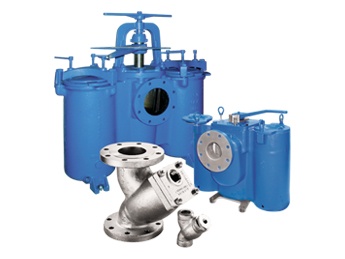
 Filters and strainers are used to remove pollutants and contaminants from water and other liquids, remove debris that could damage downstream equipment, and to help maximize manufacturing efficiency, as discussed in Filtration 101: Why Should You Filter Your Water For Manufacturing?.
Filters and strainers are used to remove pollutants and contaminants from water and other liquids, remove debris that could damage downstream equipment, and to help maximize manufacturing efficiency, as discussed in Filtration 101: Why Should You Filter Your Water For Manufacturing?.
Last week, we outlined several filtration and strainer technologies, so this week we're taking it a step further by sharing 6 factors you should consider when sizing and selecting a filter or strainer for your application.
Understanding the type and size of particles filtered allows you to select the right micron size for the filter. For example, well water contains inorganic debris, such as sand, where pond or surface water contains largely organic matter, such as algae and leaves. Typically, inorganic matter will require a smaller screen to trap the sand and sediment that would otherwise pass through a larger one. Water is only one example. You can also filter viscous products, such as paper coatings, paint, honey, and everything in between.
Flow rate determines the size of filter you need. For example, a 2" filter that accommodates a 100 gpm flow will not work for a system operating at 150 gpm. If this were the case and you were operating at a maximum flow of 150 gpm, then you would select a filter one size larger.
*Please note: If you are using a backwashing filter, minimum flow rate must be considered in addition to maximum flow.
Every filter is rated for a maximum pressure of operation; therefore it is very important to have an accurate measurement of maximum pressure when sizing and selecting a filter. Minimum operating pressure is not a requirement for all types of filters, but it is important when using an automatic, self-cleaning filter for your application. When the filter's flushing mechanism is engaged, minimum operating pressure must be maintained.
Pressure drop refers to a decrease in fluid pressure across a piping component, such as a filter. As liquid is forced through the filter media where contaminates are removed, it changes direction several times. This action causes a certain amount of resistance to the flow of the liquid resulting in lower pressure after the liquid passes through the filter. Several factors contribute to pressure drop, such as the filter media, contaminants present, flow rate, and viscosity.
Why should you care about pressure drop? As the filter bag or strainer begins to fill, the pressure drop increases as the filtered debris reduces the filter's surface area. Once a point is reached where the pressure to overcome this is too great, the desired flow through the filter will be compromised. The amount of filter surface area and the loading of particulate being filtered will determine the frequency it needs to be emptied. If pressure drop is too high to begin with, the filter will reach a point of no return very quickly and will clog.
Interested in learning more? Continue reading about pressure drop (or Delta P) on Eaton Filtration's blog.
Automatic, self-cleaning filters are known to be a higher initial investment when compared to manual filters and strainers. When choosing between automatic and manual filtration, or just selecting a filter media altogether, consider the following criteria associated with cost:
Some filtration media are suited for highly toxic liquids, where others are not. You must determine if operator and environmental exposure to the liquid is acceptable or not when looking to filter it.
At first glance, choosing a filter or strainer may seem simple and straightforward. But, as you dive deeper into it, there are a number of things to be considered, ensuring you're getting the right filter or strainer for the application and purpose. If a filter or strainer is catching too little debris, for example, damage to the whole system, or finished product can occur. Don't let this happen to you!
Contact us today if you need help with your next filtration project! We gladly provide technical assistance to businesses in Wisconsin, Minnesota, Iowa, and upper Michigan.
These Stories on Filters
Headquarters and Service Center
Located outside Green Bay, WI
707 Ford Street
Kimberly, WI 54136
920-733-4425
OptiFlow Design and Build Center
1002 Truman Street
Kimberly, WI 54136
920-733-4425
Burnsville Service Center
12265 Nicollet Avenue
Burnsville, MN 55337
952-444-1949
Grand Rapids Service Center
26489 Industrial Blvd
Cohasset, MN 55721
952-444-1949
© Copyright 2024. Crane Engineering. All Rights Reserved. Privacy Policy.